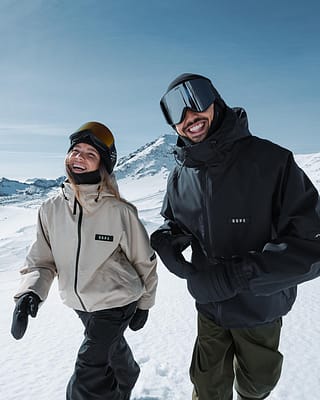Gloves vs mittens: What’s better for skiing and snowboarding?
You might think layers and outerwear are the most important part of your skiing setup. But try to grasp ski poles or drag lifts with freezing, aching hands, and you soon realize that gloves and mittens are pretty darn key. However, which is better? The battle between gloves or mittens for skiing and snowboarding is going to be settled right here…

Some riders choose any old gloves or mitts and quickly regret it. After all, these are what keep your hands toasty, comfortable, and dry for holding ski poles, knuckle dragging deep turns, and high-fives and fist bumps in every temp and condition. So, choosing wisely is key. However, did you know there are a few key differences between gloves and mittens?
Don’t worry, though, because Dope Mag is here to break things down. We lift the lid on the pros and cons, how to keep your gloves in tip-top condition, and, ultimately, which setup is best for you. So, let’s get into it, shall we?
Which one should you add to your gear lineup?
What’s the difference between gloves and mittens?
Key factors when choosing gloves or mittens
Performance comparison
Maintaining your gloves or mittens
FAQs
What’s the difference between gloves and mittens?

Mittens and gloves seem similar from the outside. They’re just different shapes, right? Well, sorry to burst your bubble, but there’s more than meets the eye (or hand). So, let’s get into more detail and discover the pros and cons…
Mittens
Apart from your thumb, mittens house all your fingers together in one compartment so they can share warmth and create a little microclimate, warming each other up on the hill. They also often have less total surface area than gloves, meaning less body heat can escape. We’re giving the game away, though. Let’s look closer at the pros and cons…
Pros of mittens
- Trap and retain heat, making them ideal for super-cold conditions or riders who feel the chill more
- Boost comfort thanks to their spacious interior
- Easier to wear liner gloves underneath
Cons of mittens
- Deliver less dexterity than gloves
- Potentially less breathable than gloves, and so less suited to high-intensity activities,
- Your fingers might get sweaty together
Gloves
With ski gloves, each digit has its own individual space. But does that make gloves superior to mitts? Let’s take a look at the for and against list…
Pros of gloves
- Prioritize dexterity for more precise movements, such as zipping up your ski jacket or using a smartphone (if your gloves have touchscreen compatibility, of course)
- Provide reliable grip on equipment such as poles, bindings, and goggles
- More breathable thanks to increased surface area
Cons of gloves
- Offer less warmth than mittens
- Don’t look as good when fist-bumping (trust us, we’ve tried)
- You can get the dreaded numb pinky in cold conditions

Key factors when choosing gloves or mittens
When choosing gloves or mittens, don’t select a style only because you love the color or print (although style points are mega important!). Instead, there are a few other key elements to keep in mind…
Dexterity and grip
Gloves are particularly useful for days involving high manual dexterity. That might be ski tours involving frequent kit adjustments and transitions to downhill mode. Alternatively, you might tap on your smartphone lots during the gondola ride up (but only possible if your gloves are touchscreen compatible). Mittens aren’t so great at dexterity, and you can’t throw and show peace signs in the park as easily. So there’s that.
Because of their anatomical design, gloves also provide better grip than mittens, which is awesome for pole planting. However, this isn’t a hard-and-fast rule. Some mittens have textured palms or thumbs to boost traction and make holding ski poles just as easy. So, check the gloves or mitts you’re lining up to see if their features match your riding style.
Warmth and comfort
Fan of riding on days so cold that your hair turns white? Or do you feel the chill even in spring? Reach for mittens. Their smoosh-your-fingers-together design helps retain heat for longer, so your hands stay cozy and protected. Different gloves and mittens also offer various levels of insulation. So, you could choose insulated designs for cold conditions and move to shell constructions for hotter temps. You can also keep your hands extra warm and dry by choosing windproof materials.
Liner gloves also exist. These are thinner than normal ski gloves. However, they’re designed to be worn under gloves and mittens to boost warmth and comfort when it’s super cold. You can also wear liners alone for spring park sessions or when ski touring. Not a fan of liners to boost heat? Try hand warmers instead.
Weather resistance and breathability
We all love toasty digits. But there’s a fine line between feeling warm one minute and having sweaty palms the next. To avoid this, make sure your gloves or mittens are breathable and allow sweat to escape. Without moisture management capabilities, you’ll experience moisture buildup, leading to clammy, chilly hands. Yuck.
Of course, allowing too much moisture in from the outside can also lead to cold hands. So, it’s worth checking the specs to make sure your gloves and mittens can repel water and keep out snow. For example, are the gloves you’re looking at designed with a waterproof membrane, or do the mittens you’re eyeing up have an external waterproof coating? Either way, you’re covered. And remember that liners and park gloves are often water-resistant rather than waterproof. This means they offer lightweight protection rather than a bombproof, watertight seal.
Fit
You want your gloves and mittens to fit… like a glove. If they’re too big, your hands are less likely to stay warm, and you’ll find it difficult to grip onto ski poles. Choose a size that’s too small, though, and they’ll feel mega uncomfortable and restrict movement.
When browsing online, most brands feature size guides to help you buy the correct fit. And if you’re comparing side by side (or hand by hand), remember that mittens naturally feel a little roomier than gloves. This allows for better insulation and warmth (their trump card). Can you form a fist without the glove or mitten feeling too restrictive or tight? Congrats! You’ve found a perfect fit.

Performance comparison
Can gloves handle mega whiteouts? Can mittens take the heat? We continue our showdown and compare how each one performs.
Performance in different conditions
Different conditions can help determine whether you should wear gloves or mittens. Wake up to fresh pow in mid-January? Go for mittens, as they’ll keep your hands toasty. Some big mountain freeriders we know regularly opt for mittens, as they deliver warmth and cover when slashing elbow-deep pow.
Heading out for a spring bluebird? Gloves have you covered. As gloves are often more breathable than mittens, they’re typically perfect for encouraging airflow in hotter temps. You can also wear thin park gloves or just liner gloves for more aerobic days, such as slushy park laps or cross-country skiing.
Dexterity vs. heat retention
Because your fingers are separated when wearing gloves, dexterity reigns supreme. This means gloves are especially suited for on-the-go tweaks, such as tightening your ski boots, strapping into your board, and zipping up your jacket.
However, because of separate finger compartments, some riders find gloves less warm than mittens. On the other hand, mittens place all your fingers in the same compartment. This makes them less dexterous but cozier, as body heat is shared between the fingers, helping transform frigid runs into toasty laps.
All-round versatility
We’ve mentioned that mittens are better for colder conditions, and gloves are awesome for spring and for more dexterity. But what if you’re buying just one pair of gloves or mitts? If that’s the case, we say go for mittens. They tend to have better all-around temperature versatility, handling warm sessions and super-cold days.
And if you need to fiddle with bindings and equipment? Remove the mittens and wear liner gloves underneath. Of course, you can also look at three-fingered mittens (also known as lobster gloves, split-finger mittens, or trigger mittens). These are a mix of a glove and a mitten, with an additional chamber for your index finger to provide overall warmth and dexterity.

Maintaining your gloves or mittens
Look after your gloves and mittens, and they’ll look after you. By that, we mean they’ll last and perform for seasons to come. So, how do you maintain them? Let’s check it out…
Cleaning and washing
For both mittens and gloves, we 100% recommend following the cleaning instructions on the label, as they’ll vary depending on the brand and material. However, in general terms, the most you’ll have to do is wipe the outer shell with a damp cloth. Anything more is often super unnecessary and likely to harm the materials and performance.
Storage and drying
After a long day on the hill (and an afternoon of après!), it can be super tempting to stuff your damp mittens or gloves into your jacket pocket or helmet. However, avoid doing this! Instead, allow your gear to air dry at room temperature before storing it in a cool, dry place. This will help your gloves and mittens last longer.
Repair tips and longevity
Spot a loose thread or teeny tear? Repair them before they become bigger problems. Regularly reviewing your gloves and mittens for wear and tear goes a long way in helping them last multiple seasons. We’re talking way more than you can count on one hand.
FAQs
Which is better for skiing?
As you’ve probably gleaned by now, mittens and gloves have their own advantages. Mittens can boost warmth thanks to the ample internal space. However, gloves prioritize dexterity for better grip on ski poles and when handling equipment. So, it all depends on personal preference and your riding style.
Which is better for snowboarding?
Again, the answer to whether gloves or mittens are better for snowboarding is down to personal preference and riding style. However, some snowboarders choose mittens as they don’t have to hold onto ski poles when riding. Nevertheless, some freestylers prefer gloves, as they provide reliable grip and dexterity for board grabs and mid-air tweaks.
Should ski mittens be tight or loose?
Ski mittens should have a snug fit. By that, we mean they should be roomy enough to allow blood flow and finger wiggling, but not so spacious that they interfere with grip. No one wants mittens so big they feel like wearing oven mitts, right? At the same time, you don’t want them to feel super-tight, as they’ll only restrict movement. As a general rule, your mittens should have about a quarter-inch of space at the fingertips for a secure, comfortable fit.
Wrapping up
Who knew mittens vs. gloves was such a hot debate, right? But it’s the little things that really matter when you’re searching for gear to keep you warm, dry, and lapping those trails all day. Long story short, there’s no right or wrong answer. It’s all about your riding conditions, how much you feel the cold, and your individual shred style.
Want to give us a virtual high-five? Reach out to our team via crew@dopesnow.com. They’re online and ready to take on praise, constructive criticism, or just say whatsup. So, drop them a message today.
Related reading:
